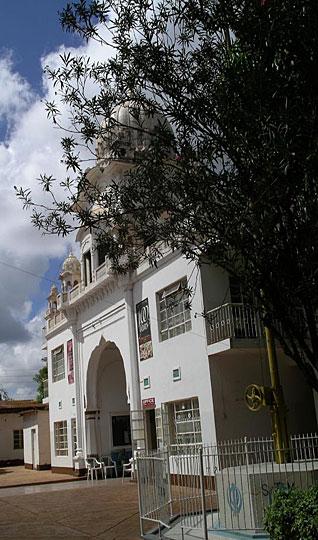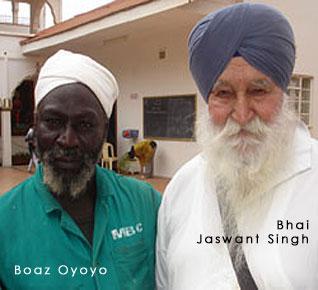Archived_Member16
SPNer
source: sikhchic.com
The Open Temple of Makindu
<SMALL>by DAUTI KAHURA</SMALL>


In the dusty plains of Makindu, a rural outpost along Nairobi-Mombasa highway in ( KENYA ) East Africa, stands a landmark that has shaped the history of an otherwise forlorn and obscure settlement.
Located about 170 km from Nairobi, the Makindu Sikh Temple is a conflation of historical and religious events that date back 100 years.
And it is because of the temple that many know Makindu as a pilgrims' sojourn.
The temple's tall flag-mast (Nishaan Sahib), a trademark for all Sikh temples worldwide, stands out from afar. Draped in yellow cloth, the 151 ft. mast can be spotted by motorists on the highway from a distance.
The Makindu Gurdwara is revered by Sikhs the world over. There is a mystical ambience about it. About 10 granthis, sporting white kaftans, run the gurdwara. They move in rhythmic motion and maintain a studious silence only broken when they are consulting workers, who are about 60.
The presence of two pea{censored}s parading their majestic feathers adds a mystical denouement to the Gurdwara. Each of the granthis carries a kirpan, the Sikh article of faith - which is worn by all Sikhs who follow the full discipline of the faith.
Bhai Manmohan Singh, 65, is the longest-serving granthi at the temple, having arrived there in 1974.
"Makindu holds a special place ... Sikhs from all over the world come here," says Manmohan Singh.
When we visited the gurdwara one Saturday, Boaz Oyoyo, 60, welcomed us.
Oyoyo is from Vihiga District and has worked in the gurdwara since 1979. Over time, he acquired the name Black Kalasinga (the black Sikh). He spots a white turban and keeps a greying beard.
"When I first came to work at the temple, all these buildings were not there. We used to eat there (points at a Malindi palm tree) because that is where the kitchen was. Today, the dining hall and the kitchen have capacity for more than 100 people a sitting," he explains.
He speaks Punjabi fluently and can recite Sikh prayers like a master. Yet, it is his mastery of Kikamba and Sikh culture that has set him aside.
"The Kalasingas (Kiswahili for Sikhs) have been good to me. In the many years I have worked with them, we have forged a lasting friendship and a deeper understanding of each other," he says.
Although his long stay in Makindu has made him sort of a celebrity in the area, he still travels to his rural home in Vihiga.
He is currently overseeing the construction of a prayer hall, which will be spruced up by a water fountain. Also under construction are cottages for invalids and old pilgrims. A one-stop lift to ferry the pilgrims to the upper shrine will also be built.
From a makeshift structure that was the gurdwara in the early years of its existence, it now has more than 200 hotel-class rooms that host guests for free.
And one does not have to be an adherent of Sikhism to stay at the gurdwara. From local and foreign tourists to children on a school trip, all are welcome.
"The Sikhs encourage travellers to stop by to relax, eat and enjoy the serenity and if they are too tired, they can sleep the night over," says Oyoyo.
The Gurdwara can host up to 4,000 people. "When we have such a large number, it is the very old and children who sleep in the rooms. Others sleep in their cars or pitch tent in the compound," he says.
Augustino Mwange, the chief chef, has worked at the gurdwara for the past 10 years and has become a Sikh cuisine expert. "There are travellers who stop by at midnight, and when they come to the dining hall, they will always find something hot," says Mwange, who hails from Machakos.
"I've been coming here since I was five," says Tony Kosgey, 36.
When I met Kosgey who was on his way to Taita Hills, he was accompanied by his nine-year-old son. "It is a tradition that runs through my family and I want my son also to experience and keep it."
Amin Premji, 52, has also kept the tradition. "The philosophy of The Makindu Temple is that all races come together to experience the sanctity of humanity in a holy sanctuary. Over time, that is what I have learnt from my coming here".
The gurdwara runs purely on donations from well-wishers, mostly local businessmen.
Billay Singh Kalsi, 59, travelled from Leicester, UK, to visit the gurdwara. "We came purposely to Kenya to visit the gurdwara," said Billay Singh, who was accompanied by wife and daughter.
Yet others come to the gurdwara for thanksgiving after a milestone in their life.
For instance, Harjeet Singh Manku is at the gurdwara because his daughter's wedding has been a success. "When I arrive at Makindu, I experience sublime peace and calmness," he says.
Vic Tyson, a tourist from Vancouver, Canada, says a visit to Kenya would be incomplete without stopping by the gurdwara.
Across the road, the management has put up a hospital to serve locals. "The hospital charges Sh 50 for any treatment, but we have never chased anybody away due to lack of money," says Dr David Kimani, an ophthalmologist at the hospital.
Among personalities who would never miss a chance to visit the gurdwara was Kenya's founding President Jomo Kenyatta, says Makindu Temple Committee Chairman, Mohinder Singh Vohra
[Courtesy: The Standard] August 26, 2009
The Open Temple of Makindu
<SMALL>by DAUTI KAHURA</SMALL>


In the dusty plains of Makindu, a rural outpost along Nairobi-Mombasa highway in ( KENYA ) East Africa, stands a landmark that has shaped the history of an otherwise forlorn and obscure settlement.
Located about 170 km from Nairobi, the Makindu Sikh Temple is a conflation of historical and religious events that date back 100 years.
And it is because of the temple that many know Makindu as a pilgrims' sojourn.
The temple's tall flag-mast (Nishaan Sahib), a trademark for all Sikh temples worldwide, stands out from afar. Draped in yellow cloth, the 151 ft. mast can be spotted by motorists on the highway from a distance.
The Makindu Gurdwara is revered by Sikhs the world over. There is a mystical ambience about it. About 10 granthis, sporting white kaftans, run the gurdwara. They move in rhythmic motion and maintain a studious silence only broken when they are consulting workers, who are about 60.
The presence of two pea{censored}s parading their majestic feathers adds a mystical denouement to the Gurdwara. Each of the granthis carries a kirpan, the Sikh article of faith - which is worn by all Sikhs who follow the full discipline of the faith.
Bhai Manmohan Singh, 65, is the longest-serving granthi at the temple, having arrived there in 1974.
"Makindu holds a special place ... Sikhs from all over the world come here," says Manmohan Singh.
When we visited the gurdwara one Saturday, Boaz Oyoyo, 60, welcomed us.
Oyoyo is from Vihiga District and has worked in the gurdwara since 1979. Over time, he acquired the name Black Kalasinga (the black Sikh). He spots a white turban and keeps a greying beard.
"When I first came to work at the temple, all these buildings were not there. We used to eat there (points at a Malindi palm tree) because that is where the kitchen was. Today, the dining hall and the kitchen have capacity for more than 100 people a sitting," he explains.
He speaks Punjabi fluently and can recite Sikh prayers like a master. Yet, it is his mastery of Kikamba and Sikh culture that has set him aside.
"The Kalasingas (Kiswahili for Sikhs) have been good to me. In the many years I have worked with them, we have forged a lasting friendship and a deeper understanding of each other," he says.
Although his long stay in Makindu has made him sort of a celebrity in the area, he still travels to his rural home in Vihiga.
He is currently overseeing the construction of a prayer hall, which will be spruced up by a water fountain. Also under construction are cottages for invalids and old pilgrims. A one-stop lift to ferry the pilgrims to the upper shrine will also be built.
From a makeshift structure that was the gurdwara in the early years of its existence, it now has more than 200 hotel-class rooms that host guests for free.
And one does not have to be an adherent of Sikhism to stay at the gurdwara. From local and foreign tourists to children on a school trip, all are welcome.
"The Sikhs encourage travellers to stop by to relax, eat and enjoy the serenity and if they are too tired, they can sleep the night over," says Oyoyo.
The Gurdwara can host up to 4,000 people. "When we have such a large number, it is the very old and children who sleep in the rooms. Others sleep in their cars or pitch tent in the compound," he says.
Augustino Mwange, the chief chef, has worked at the gurdwara for the past 10 years and has become a Sikh cuisine expert. "There are travellers who stop by at midnight, and when they come to the dining hall, they will always find something hot," says Mwange, who hails from Machakos.
"I've been coming here since I was five," says Tony Kosgey, 36.
When I met Kosgey who was on his way to Taita Hills, he was accompanied by his nine-year-old son. "It is a tradition that runs through my family and I want my son also to experience and keep it."
Amin Premji, 52, has also kept the tradition. "The philosophy of The Makindu Temple is that all races come together to experience the sanctity of humanity in a holy sanctuary. Over time, that is what I have learnt from my coming here".
The gurdwara runs purely on donations from well-wishers, mostly local businessmen.
Billay Singh Kalsi, 59, travelled from Leicester, UK, to visit the gurdwara. "We came purposely to Kenya to visit the gurdwara," said Billay Singh, who was accompanied by wife and daughter.
Yet others come to the gurdwara for thanksgiving after a milestone in their life.
For instance, Harjeet Singh Manku is at the gurdwara because his daughter's wedding has been a success. "When I arrive at Makindu, I experience sublime peace and calmness," he says.
Vic Tyson, a tourist from Vancouver, Canada, says a visit to Kenya would be incomplete without stopping by the gurdwara.
Across the road, the management has put up a hospital to serve locals. "The hospital charges Sh 50 for any treatment, but we have never chased anybody away due to lack of money," says Dr David Kimani, an ophthalmologist at the hospital.
Among personalities who would never miss a chance to visit the gurdwara was Kenya's founding President Jomo Kenyatta, says Makindu Temple Committee Chairman, Mohinder Singh Vohra
[Courtesy: The Standard] August 26, 2009




